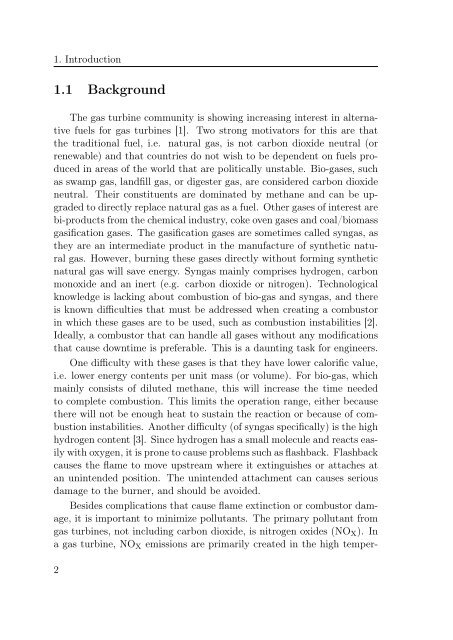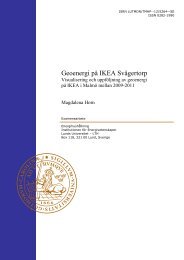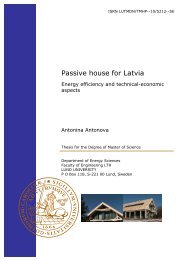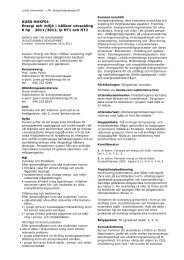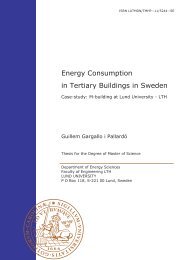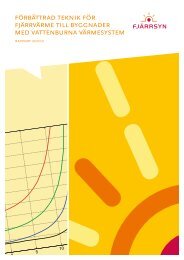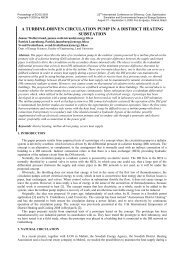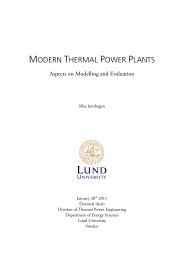investigation of a prototype industrial gas turbine combustor using ...
investigation of a prototype industrial gas turbine combustor using ...
investigation of a prototype industrial gas turbine combustor using ...
Create successful ePaper yourself
Turn your PDF publications into a flip-book with our unique Google optimized e-Paper software.
1. Introduction<br />
1.1 Background<br />
The <strong>gas</strong> <strong>turbine</strong> community is showing increasing interest in alternative<br />
fuels for <strong>gas</strong> <strong>turbine</strong>s [1]. Two strong motivators for this are that<br />
the traditional fuel, i.e. natural <strong>gas</strong>, is not carbon dioxide neutral (or<br />
renewable) and that countries do not wish to be dependent on fuels produced<br />
in areas <strong>of</strong> the world that are politically unstable. Bio-<strong>gas</strong>es, such<br />
as swamp <strong>gas</strong>, landfill <strong>gas</strong>, or digester <strong>gas</strong>, are considered carbon dioxide<br />
neutral. Their constituents are dominated by methane and can be upgraded<br />
to directly replace natural <strong>gas</strong> as a fuel. Other <strong>gas</strong>es <strong>of</strong> interest are<br />
bi-products from the chemical industry, coke oven <strong>gas</strong>es and coal/biomass<br />
<strong>gas</strong>ification <strong>gas</strong>es. The <strong>gas</strong>ification <strong>gas</strong>es are sometimes called syn<strong>gas</strong>, as<br />
they are an intermediate product in the manufacture <strong>of</strong> synthetic natural<br />
<strong>gas</strong>. However, burning these <strong>gas</strong>es directly without forming synthetic<br />
natural <strong>gas</strong> will save energy. Syn<strong>gas</strong> mainly comprises hydrogen, carbon<br />
monoxide and an inert (e.g. carbon dioxide or nitrogen). Technological<br />
knowledge is lacking about combustion <strong>of</strong> bio-<strong>gas</strong> and syn<strong>gas</strong>, and there<br />
is known difficulties that must be addressed when creating a <strong>combustor</strong><br />
in which these <strong>gas</strong>es are to be used, such as combustion instabilities [2].<br />
Ideally, a <strong>combustor</strong> that can handle all <strong>gas</strong>es without any modifications<br />
that cause downtime is preferable. This is a daunting task for engineers.<br />
One difficulty with these <strong>gas</strong>es is that they have lower calorific value,<br />
i.e. lower energy contents per unit mass (or volume). For bio-<strong>gas</strong>, which<br />
mainly consists <strong>of</strong> diluted methane, this will increase the time needed<br />
to complete combustion. This limits the operation range, either because<br />
there will not be enough heat to sustain the reaction or because <strong>of</strong> combustion<br />
instabilities. Another difficulty (<strong>of</strong> syn<strong>gas</strong> specifically) is the high<br />
hydrogen content [3]. Since hydrogen has a small molecule and reacts easily<br />
with oxygen, it is prone to cause problems such as flashback. Flashback<br />
causes the flame to move upstream where it extinguishes or attaches at<br />
an unintended position. The unintended attachment can causes serious<br />
damage to the burner, and should be avoided.<br />
Besides complications that cause flame extinction or <strong>combustor</strong> damage,<br />
it is important to minimize pollutants. The primary pollutant from<br />
<strong>gas</strong> <strong>turbine</strong>s, not including carbon dioxide, is nitrogen oxides (NO X ). In<br />
a <strong>gas</strong> <strong>turbine</strong>, NO X emissions are primarily created in the high temper-<br />
2


